There are three genera of Leptophlebiidae present in the British: Habrophlebia; Leptophlebia; and Paraleptophlebia comprising one, two and three species respectively. This guide is designed to help with the identification of these species.
First steps
Mature nymphs are easy to take to genus if they still have their gills attached (Figure 1). I say ‘if’ as gills on Leptophlebiid nymphs seem to be a bit of an optional extra as they readily fall off during sampling and handling.

|

|

|
| Habrophlebia |
Leptophlebia |
Paraleptophlebia |
Figure 1: Gill shape of Leptophlebiidae genera
Habrophlebia has multiple branching gills, like little trees. The gills of Paraleptophlebia are like little letter ‘Y’s or tuning forks. Those of Leptophlebia are similar but broaden out from the base to form a flattened plate. Be careful because the gills of immature Leptophlebia don’t broaden out until the nymphs are about half grown and until then they resemble the strap-like gills of Paraleptophlebia. This often catches people out and a number of records of Paraleptophlebia werneri – a relatively rare species – have turned out to be immature Leptophlebia marginata. Soif you’ve got a small specimen (<5mm) or the gills are damaged you’ll have to look at the mouthparts to separate the genera. The idea of looking at mouthparts usually fills the novice with dread but it’s actually relatively straightforward. First you’ll need a preserved specimen as you’ll need to detach the head from the body and then ‘pick out’ the mouthparts under a microscope with a fine needle. You’re looking for the maxilla and the maxillary palp. The image at https://www.for.gov.bc.ca/hts/risc/pubs/aquatic/mayfly/assets/ms1996-5.jpg should help you locate them. Once you’ve found them the genus can be confirmed as follows. In Habrophlebia and Leptophlebia the maxillary palp is shorter than themaxilla, whereas in Paraleptophlebia the maxillary palp is longer than the maxilla (Figure 2).
|
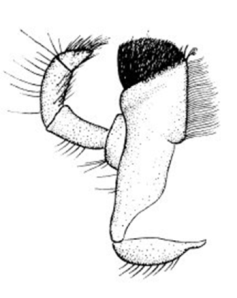 Habrophlebia Habrophlebia
|
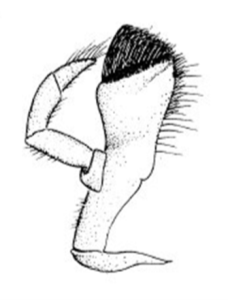 Leptophlebia Leptophlebia |
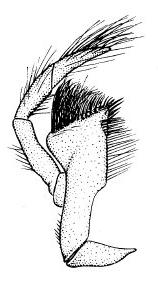 Paraleptophlebia Paraleptophlebia
|
Figure 2: Maxilla and Maxillary Palps of Leptophlebiidae genera
Taking it to species
Habrophlebia is easy to take to species – or it should be! There is only one species, Habrophlebia fusca, known from the British Isles and if you’ve checked what’s left of the gills and confirmed with the mouthparts you’re there! However keep an eye out for the possibility of European species turning up in the UK. Thraulus spp. are similar to Habrophlebia but the first gill is made up of two simple branches (like a letter ‘Y’ or a tuning fork – see Paraleptophlebia below). Other European species ofHabrophlebia might also appear in the UK. Habrophlebia fusca has 2 to 4 filaments on the small branch of gills 2 to 6. If you suspect you’ve got a different Habrophlebia sp. or Thraulus sp. then get in touch with the Ephemeroptera Recording Scheme.
To separate the two Leptophlebia spp. take a look at the gills (Figure 3). In L. vespertina the wide part of the gills tapers gradually towards the tip, whereas in L. marginata the wide part ends abruptly about halfway along the gill. To confirm the identification you can take a look at the claws (Figure 4). If the teeth cover nearly the whole length of the claw it’s L. vespertina, if they stop short (3/4 along the claw) it’s L. marginata. If you really want to be sure check the bristles on the femur (Figure 5). These bristles are, I have to admit, difficult to see but if you’ve got enough magnification (between x60 and x100) and have decent lighting you should be able to make them out. In Leptophlebia marginata the bristles are simple and pointedwhereas in L. vespertina they have many little points up the sides which gives them a feathery, spiky appearance, or at lower magnification, a fuzzy, indistinct outline.
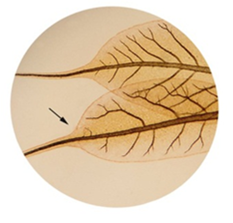 Leptophlebia marginata Leptophlebia marginata |
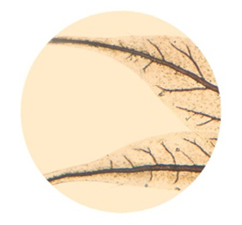 Leptophlebia vespertina Leptophlebia vespertina |
Figure 3: Gills of mature Leptophlebia spp.
 Leptophlebia marginata Leptophlebia marginata |
 Leptophlebia vespertina Leptophlebia vespertina |
Figure 4: Teeth on tarsal claw of Leptophlebia spp.
 Leptophlebia marginata Leptophlebia marginata |
 Leptophlebia vespertina Leptophlebia vespertina |
Figure 5: Bristles on the femur of Leptophlebia spp.
You can compare the relative size of the first and second gills to separate Paraleptophlebia submarginata from P. cincta and P. werneri. The first gill is around half the size of the second in P. submarginata, whereas in the other species they are of a similar size, however as you rarely have a full complement of gills I usually skip this step. As a result you’ll have to look at the coverage of teeth on the claws and the shape of the bristles on the femur to make an identification. In Paraleptophlebia submarginata and P. cincta the teeth cover just over half the length of the claw, whereas in P. werneri they cover around three quarters (Figure 7). If you think you’ve got a specimen of Paraleptophlebia werneri then you’re either really lucky (it’s a highly localised species of winterbournes and ditches), or more likely, you’ve got an immature specimen of Leptophlebia marginata – look again at the mouthparts to separate the genera. The final thing to look at is the spines on the underside of the hind femur. Again, these are difficult to see but with the right magnification and lighting you should be able to pick them out. In Paraleptophlebiasubmarginta they are cylindrical with blunt tips, whereas in the other species they taper to a point which is blunt in P. cincta and pointed in P. werneri.

P. submarginata
|

P. cincta/werneri
|
Figure 6: Comparison of first and second gills in Paraleptophlebia spp.
 P. submarginata/cincta P. submarginata/cincta |
 P.werneri P.werneri
|
Figure 7: Teeth on tarsal claw in Paraleptophlebia spp.
 |
 |
 |
| P. submarginata |
P. cincta |
P. werneri |
Figure 8: Spines on underside of hind leg of Paraleptophlebia spp.
So there you have it. The identification of British Leptophlebiidae is relatively straightforward once you get the hang of it. Remember not to force an identification– if you can’t see the feature or discern the differences between species it’s okay to leave the identification at the genus level. Please also remember to add your records to iRecord (www.brc.ac.uk/irecord). You can add images to your records which will help with the verification process.
Acknowledgements
The photographs in this guide are copyright Cyril Bennett. The diagrams in figure 2 are Peters, W.L. and Edmunds, G.F. (1970). Revision of the Generic Classification of The Eastern Hemisphere Leptophlebiidae (Ephemeroptera). Pacific Insects 12(1): 157-240. The diagrams in figure 8 are taken from Macan T.T. (1952). Taxonomy of the
British species of Leptophlebiidae (Ephem.). Hydrobiologia 4(4):363-376. All other line diagrams were produced by Rory McCann and are taken from Macadam, C. and Bennett, C. (2010). A Pictorial Guide to British Ephemeroptera. Field Studies Council, Shrewsbury.
You can download a PDF of this guide Notes on the identification of Leptophlebiidae nymphs
Brachycercus harrisellus has a widespread, though patchy distribution throughout the country. The most northerly records are from the River Forth in Stirlingshire and the River Black Devon in Clackmannanshire. Nymphs of this species live in the pools and margins of rivers and streams, where they burrow into, and live on mud and silt on the bed of the watercourse. They are poor swimmers but are adapted for moving amongst mud and silt where they feed by collecting or gathering fine particulate organic detritus from the sediment.
There is one generation a year, which usually overwinters as eggs and emerges in July.
Cloeon simile is a common and widespread species that is found throughout the British Isles. It is thought that this species is the least common of the British Cloeon spp. Nymphs of this species live in pools and margins of rivers and streams or in deeper water in larger lakes. The nymphs swim in short, darting bursts amongst the substrate, or climb amongst the vegetation. They feed by scraping algae from submerged stones and other structures, or by gathering or collecting fine particulate organic detritus from the sediment.
There are usually two generations a year, one of which overwinters as nymphs and emerges in the spring. This species has a particularly long flight period with adults generally seen between March and November.
Emergence of the adults typically takes place at the surface during daylight hours, with the males of this species swarming during the morning and afternoon. Once mated, the female descends to the surface of the water and releases a few eggs by dipping the tip of her abdomen onto the water surface at intervals, or by actually settling on the surface for short periods. After several visits to the water her supply of up to 3500 eggs is finished and the spent female falls on to the surface.
Caenis rivulorum is the most common and widely distributed of the British Caenidae. It can be found throughout the British Isles and Ireland, although it has a relatively localised distribution in the South East of England. Nymphs of this species live in the pools and margins of stony rivers and streams, where they live in silt trapped between larger stones and gravel. The nymphs are poor swimmers but are adapted for moving amongst the sediment. They feed by collecting or gathering fine particulate organic detritus from the sediment.
There is one generation a year which overwinters as nymphs and emerges as adults between May and September. Emergence of the adults probably takes place partially or entirely out of the water on a stick, stones or plant stem at dusk or dawn.
Ephemera lineata is the rarest of the British Ephemeridae. It is currently known from the River Thames and the River Wye (Monmouthshire) but may occur in other watercourses. Nymphs of this species live in the pools and margins of large rivers where they dig into the substrate to form a tubular burrow. They use their gills to force the water through this burrow and the nymphs feed by filtering or collecting fine particulate organic detritus from the water column. Ephemera lineata has a two-year life cycle, however some populations may have an annual lifecycle. Adults are usually seen in July. Emergence of the adults probably takes place at dusk or dawn on the surface of the water or occasionally on a stick, stone or plant stem partially or entirely out of the water.
Nymphs of this species are typically found in riffle areas of rivers and streams. They are usually found clinging to submerged plants and stones, although they may swim if disturbed. E. venosus feeds either by scraping periphyton from the substrate or by gathering fine particulate organic detritus from the sediment. There is one generation a year, which usually overwinters as nymphs and emerges between April and July, and often as late as September or October.
Emergence of the adults takes place at the surface of the water and often continues well into dusk. The males of this species can be found swarming throughout the day. Once mated, the female either flies upstream and descends to the surface of the water to release a few eggs by dipping the tip of her abdomen on to the surface at intervals, or by resting on a stone above the water and laying her eggs on the river bed by dipping her abdomen below the surface. After several visits to the water the egg supply of up to 6000 eggs is finished and the spent female falls on to the surface.
Due to the problems with identification of nymphs, it is difficult to compile a complete distribution for this species. E. venosus is however, thought to occur in suitable habitats throughout the UK and Ireland.
There are few published records for Siphlonurus alternatus from mainland Britain, although it is known from several locations in Ireland. Nymphs of this species typically live in deep pools in rivers and streams, but can also be found in calcareous lakes. The large nymphs are good swimmers and typically swim in short, darting bursts. They feed by gathering or collecting fine particulate organic detritus from the sediment. There is one generation a year, which usually overwinters as eggs and emerges between May and August. Emergence of the adults typically takes place during daylight hours and males of this species can be found swarming at dawn and dusk.
Habrophlebia fusca is common in central England but has a scattered, localised distribution through out mainland Britain. There are few records North of the Central belt of Scotland and it appears to be absent from the North West of Scotland. Nymphs of this species live chiefly in the pools and margins of rivers and stream, where they are found amongst plant life or amongst accumulations of dead leaves. They live on the surface of leaves of aquatic plant or in the surface layers of fine sediments, especially mud where they feed either by filtering or gathering fine particulate organic detritus from the sediment. The nymphs are poor swimmers but are adapted for moving amongst dense stands of plants, especially on the surface of the stems. There is one generation per year that overwinters as nymphs and emerges between May and September.
Emergence of the adults typically takes place partially or entirely out of the water on a stick, stones or plant stem during daylight hours. Once mated, the female flies upstream and descends to the surface of the water to release a few eggs by dipping the tip of her abdomen on to the surface at intervals, or by actually settling on the surface for short periods. After several visits to the water the egg supply of around 1200 eggs is finished and the spent female falls on to the surface.
Leptophlebia vespertina is a fairly common species which has been found throughout the British Isles, including Ireland. L. vespertina is reported to prefer peaty or acidic waters and as a result, tends to be less common from lowland waters. Nymphs of this species can be found in the pools and margins of slow flowing streams and in ponds and lakes where they climb upon the surface of leaves of aquatic plants or crawl in the surface layers of fine sediments, especially mud. The nymphs are poor swimmers but are adapted for moving amongst dense stands of plants, especially on the surface of the stems. They feed by gathering fine particulate organic detritus from the sediment. There is one generation a year, which usually overwinters as nymphs and emerges between April and August.
Emergence of the adults takes place during daylight hours at the surface of the water or more typically, partially or entirely out of the water on a stick, stone or plant stem. The males of this species can be found swarming throughout the day, and as the species name suggests, this swarming often continues well into the evening.
Once mated, the female returns to the water to release a few eggs by dipping the tip of her abdomen on to the surface at intervals, or by actually settling on the water surface for short periods. After several visits to the water her supply of around between 1200 and 2500 eggs is finished and the spent female falls on to the surface.
Ameletus inopinatus has a limited distribution in Northern England and Scotland. It is thought that the distribution of this species will shrink as water temperatures increase due to climate change. Nymphs of this species typically live in upland streams (above 300 metres), but are also found in some Highland lochs in Scotland. The nymphs are good swimmers and typically swim in short, darting bursts. They feed by gathering or collecting fine particulate organic detritus from the sediment.
There is one generation a year, which usually overwinters as nymphs and emerges between May and early August. Emergence of the adults typically takes place during daylight hours and males of this species can be found swarming in the afternoon.



 Leptophlebia
Leptophlebia Leptophlebia marginata
Leptophlebia marginata Leptophlebia vespertina
Leptophlebia vespertina Leptophlebia marginata
Leptophlebia marginata Leptophlebia vespertina
Leptophlebia vespertina Leptophlebia marginata
Leptophlebia marginata Leptophlebia vespertina
Leptophlebia vespertina

 P. submarginata/cincta
P. submarginata/cincta




